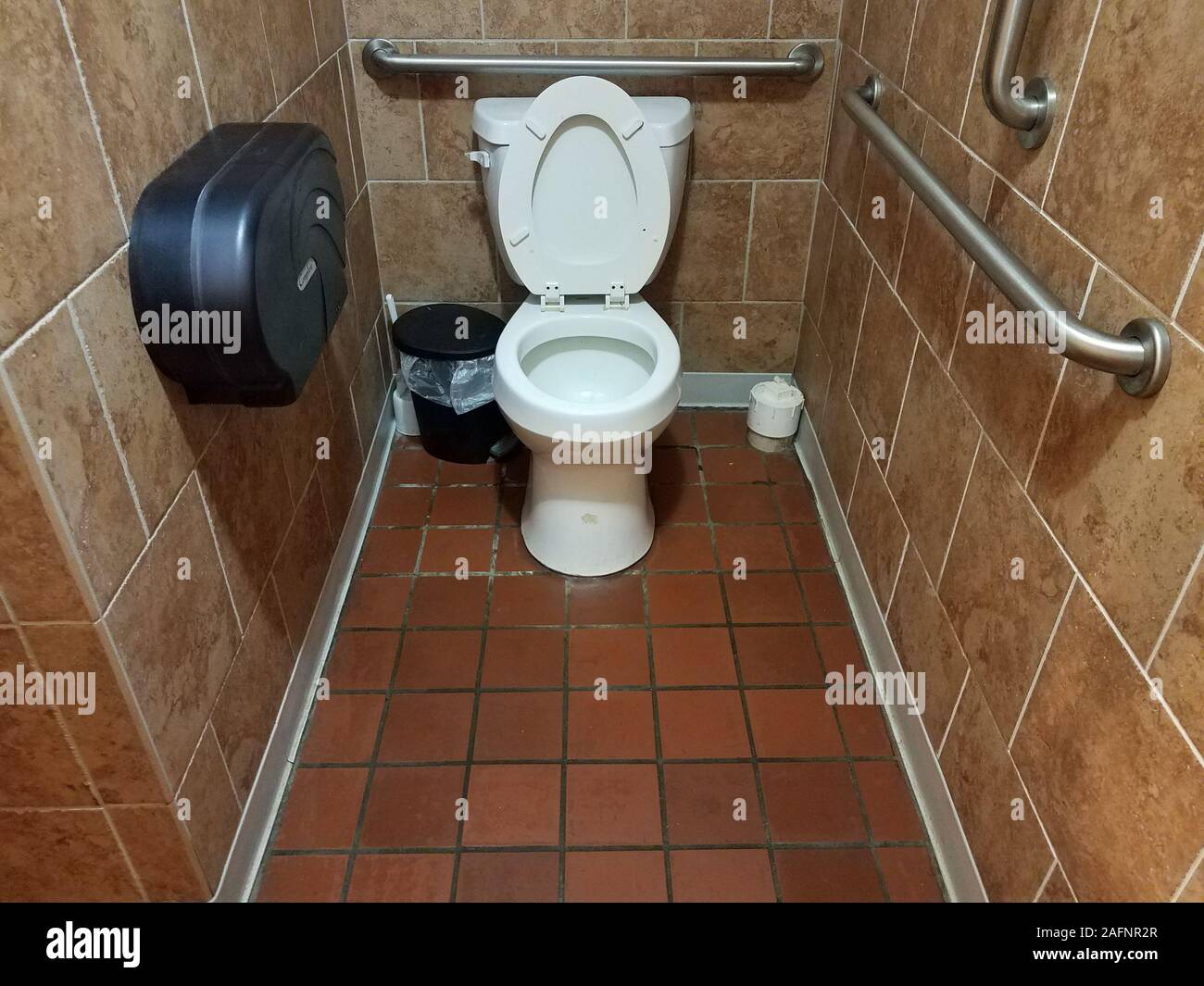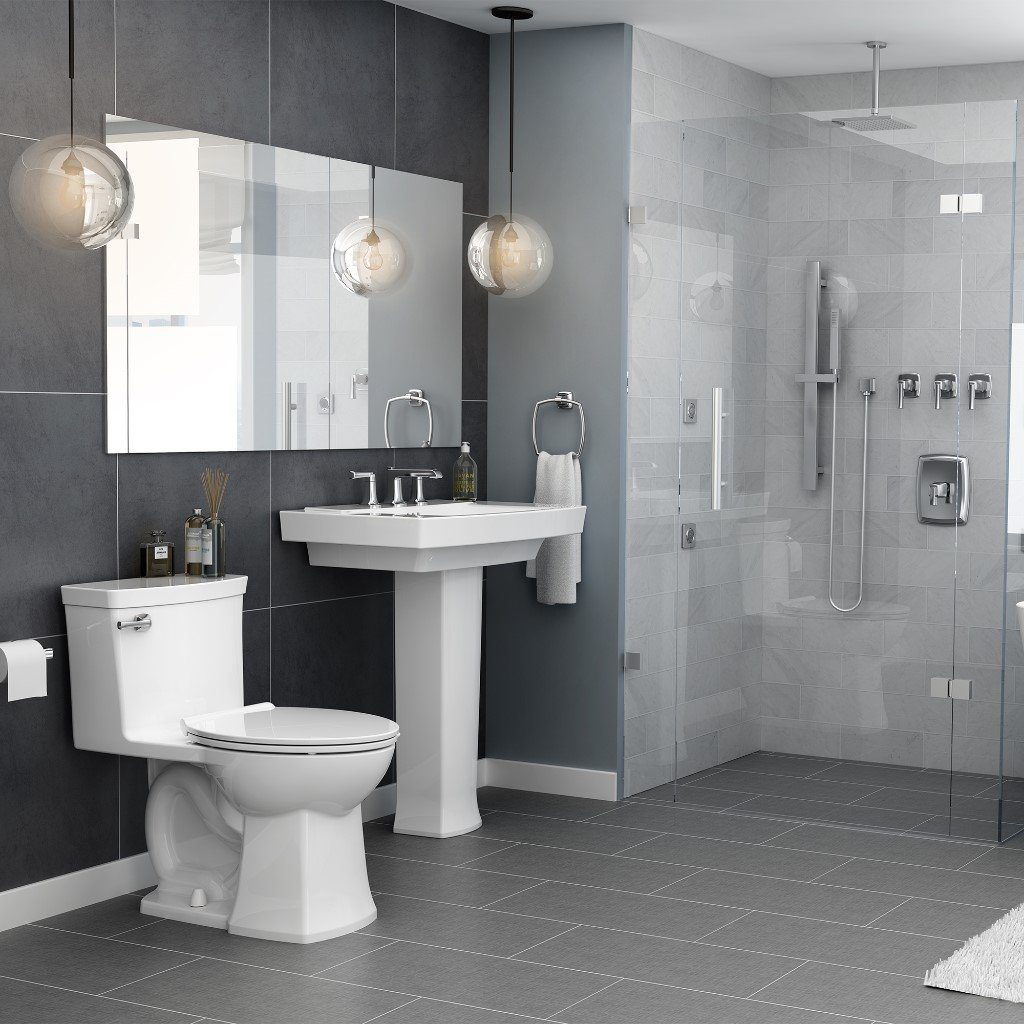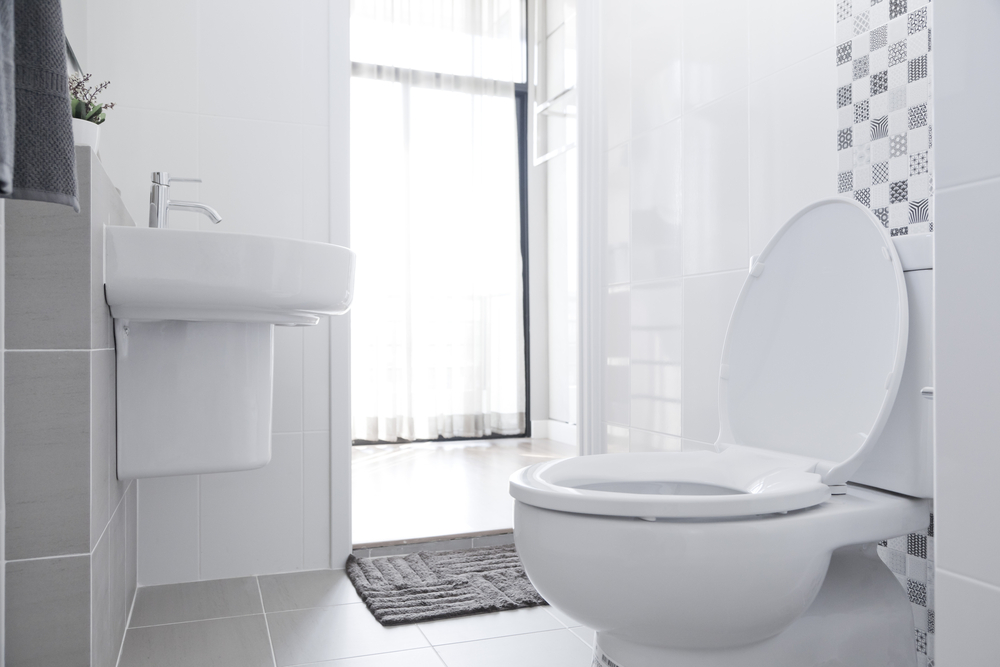Enclosed Toilet Design and Features: Enclosed Toilet In Bathroom

Enclosed toilets, also known as pod toilets or prefabricated toilet units, are becoming increasingly popular in modern bathroom design. They offer a range of advantages over traditional open toilets, including enhanced privacy, improved hygiene, and a more streamlined aesthetic.
Types of Enclosed Toilets
Enclosed toilets are available in various designs, each with unique construction materials, dimensions, and features. Here’s a breakdown of some common types:
- Prefabricated Toilet Pods: These units are fully assembled and ready for installation. They typically include a toilet bowl, tank, and a surrounding enclosure made of materials like fiberglass, acrylic, or composite panels. Prefabricated pods are known for their ease of installation and are often used in commercial or high-traffic settings.
- Custom-Built Enclosed Toilets: These toilets are designed and built on-site to meet specific requirements. They offer greater flexibility in terms of materials, size, and features. Custom-built enclosed toilets are often found in luxury homes or projects where unique aesthetics are desired.
- Modular Enclosed Toilets: These toilets consist of modular components that can be assembled and reconfigured. They offer flexibility in design and can be adapted to different bathroom layouts. Modular enclosed toilets are suitable for both residential and commercial applications.
Advantages and Disadvantages of Enclosed Toilets
Enclosed toilets provide several benefits over traditional open toilets, but they also have some drawbacks:
- Advantages:
- Enhanced Privacy: The enclosed design provides a sense of privacy and seclusion, particularly in shared bathroom spaces.
- Improved Hygiene: The enclosed space helps to contain odors and prevent the spread of germs, contributing to a cleaner and more hygienic environment.
- Streamlined Aesthetics: Enclosed toilets can enhance the overall visual appeal of a bathroom, creating a more modern and minimalist look.
- Sound Reduction: The enclosure helps to muffle noise from the toilet, reducing disturbances in the surrounding area.
- Ease of Cleaning: The smooth surfaces and enclosed design make cleaning easier and more efficient.
- Disadvantages:
- Cost: Enclosed toilets are generally more expensive than traditional open toilets, especially custom-built models.
- Space Requirements: Enclosed toilets require more space than traditional open toilets, which may be a constraint in smaller bathrooms.
- Ventilation: Proper ventilation is essential to prevent moisture buildup and ensure good air circulation within the enclosed space.
- Accessibility: Enclosed toilets can pose accessibility challenges for people with mobility impairments.
Innovative Designs and Features
Enclosed toilets are constantly evolving, with manufacturers incorporating innovative designs and features to enhance functionality and aesthetics. Here are some examples:
- Integrated Storage: Some enclosed toilets feature built-in storage compartments for toiletries, towels, or other bathroom essentials, maximizing space utilization.
- Smart Toilet Technology: Smart toilets offer features like automatic flushing, temperature control, and even bidet functionality, enhancing comfort and convenience.
- Sustainable Materials: Manufacturers are increasingly using eco-friendly and sustainable materials in the construction of enclosed toilets, reducing environmental impact.
- Customizable Finishes: Many enclosed toilets are available in a variety of finishes, allowing homeowners to match the style and decor of their bathrooms.
Comparison of Enclosed Toilet Models
| Model | Price (USD) | Size (W x D x H) | Materials | Features |
|—|—|—|—|—|
| Model A | 1,500-2,000 | 30″ x 36″ x 78″ | Fiberglass, Acrylic | Prefabricated, Integrated storage, Automatic flushing |
| Model B | 2,500-3,500 | 36″ x 42″ x 84″ | Composite panels, Stainless steel | Custom-built, Smart toilet technology, Bidet functionality |
| Model C | 1,000-1,500 | 28″ x 32″ x 72″ | Recycled plastic, Bamboo | Modular, Sustainable materials, Customizable finishes |
Enclosed Toilet Installation and Maintenance

Installing an enclosed toilet requires careful planning and execution to ensure proper functionality and longevity. It’s a process that involves specific tools, materials, and techniques, and it’s essential to prioritize plumbing and ventilation for optimal performance.
Enclosed Toilet Installation Process
Installing an enclosed toilet involves a series of steps, starting with preparation and ending with final connections. This process requires specific tools and materials, and understanding the necessary steps is crucial for a successful installation.
- Preparation: Begin by gathering the necessary tools and materials, including a level, tape measure, plumbing wrenches, a drill, and a saw. Ensure the area is clear and accessible for working.
- Plumbing Connections: Connect the toilet to the water supply and drainage system, ensuring proper sealing and leak-free connections. This step involves attaching the toilet to the water supply line and connecting the drain to the existing plumbing system.
- Enclosed Toilet Installation: Install the enclosed toilet structure, carefully aligning it with the floor and ensuring stability. This step may involve assembling prefabricated components or building a custom structure.
- Final Connections: Connect the toilet bowl to the drain, ensuring a secure and leak-free connection. Complete any final adjustments and secure the toilet to the floor.
- Testing and Adjustments: Flush the toilet to test for leaks and proper functionality. Make any necessary adjustments to ensure optimal performance.
Enclosed Toilet Maintenance, Enclosed toilet in bathroom
Maintaining an enclosed toilet involves regular cleaning, troubleshooting issues, and replacing parts as needed. Proper maintenance helps ensure the toilet’s functionality and extends its lifespan.
- Cleaning: Regularly clean the toilet bowl, seat, and surrounding areas with appropriate cleaning agents. Ensure proper ventilation during cleaning to prevent moisture buildup.
- Troubleshooting: Identify and address common issues, such as leaks, clogs, and flushing problems. Consult a professional if needed for complex repairs.
- Replacing Parts: Replace worn or damaged parts, such as the flapper, seat, and bowl. Ensure compatibility with the specific toilet model.
Ventilation and Moisture Control
Proper ventilation is crucial in enclosed toilet spaces to prevent moisture buildup and ensure a healthy environment. Maintaining adequate ventilation helps prevent mold growth and unpleasant odors.
- Exhaust Fans: Install an exhaust fan to remove moisture and odors from the enclosed space. Ensure the fan is appropriately sized and positioned for optimal ventilation.
- Air Circulation: Provide adequate air circulation within the enclosed space by opening windows or using other ventilation methods.
- Moisture Control: Use dehumidifiers or other moisture control methods to prevent excessive humidity in the enclosed space.
Enclosed Toilets in Bathroom Design

Enclosed toilets, often referred to as “wet rooms” or “shower toilets,” have become increasingly popular in contemporary bathroom design. Their ability to create a sleek, modern aesthetic while offering enhanced functionality makes them a compelling choice for homeowners seeking to upgrade their bathroom spaces.
Impact on Bathroom Design and Layout
Enclosed toilets, by their very nature, alter the traditional bathroom layout. They create a distinct, self-contained space within the bathroom, often serving as a focal point. This can influence the flow and functionality of the overall bathroom design.
- Space Optimization: Enclosed toilets can be particularly advantageous in smaller bathrooms. By creating a dedicated space for the toilet, they allow for more efficient use of the remaining bathroom area, maximizing space for other fixtures and amenities.
- Enhanced Privacy: The enclosure creates a sense of privacy and separation within the bathroom, particularly important in multi-person households.
- Aesthetic Appeal: Enclosed toilets can add a touch of elegance and sophistication to a bathroom. The enclosed space allows for creative use of materials, colors, and lighting to enhance the overall design aesthetic.
Integration with Different Bathroom Styles
Enclosed toilets can be seamlessly integrated into a wide range of bathroom styles, from modern and minimalist to traditional and eclectic.
- Modern Bathrooms: In modern bathrooms, enclosed toilets often feature sleek, minimalist designs, with clean lines and contemporary materials like glass, metal, and polished concrete.
- Traditional Bathrooms: In traditional bathrooms, enclosed toilets can be designed with a more classic aesthetic, using materials like wood, stone, and brass. They can be incorporated with ornate details, such as decorative moldings and traditional lighting fixtures.
- Eclectic Bathrooms: For eclectic bathrooms, the possibilities are endless. Enclosed toilets can be used to create unique and eye-catching focal points, blending different styles and materials to create a personalized and expressive space.
Examples of Enclosed Toilet Designs
Enclosed toilet designs can be tailored to suit specific bathroom layouts and aesthetic preferences. Here are a few examples:
- Walk-in Shower Toilets: These designs combine a shower and a toilet within a single, enclosed space. They offer a convenient and space-saving solution for smaller bathrooms, eliminating the need for separate shower stalls.
- Separate Enclosure: In larger bathrooms, enclosed toilets can be designed as a separate, self-contained space. This allows for more elaborate designs, with features like built-in storage, seating, and even decorative elements.
- Corner Toilets: Corner enclosed toilets are a popular choice for maximizing space in smaller bathrooms. They fit snugly into a corner, creating a visually appealing and functional design.
Incorporating Lighting, Ventilation, and Storage
Proper lighting, ventilation, and storage are essential for creating a functional and aesthetically pleasing enclosed toilet space.
- Lighting: Adequate lighting is crucial for creating a comfortable and inviting atmosphere. Consider using a combination of ambient and task lighting to ensure optimal visibility.
- Ventilation: Proper ventilation is essential for eliminating moisture and odors. Install an exhaust fan to ensure adequate airflow.
- Storage: Incorporate storage solutions to keep the enclosed toilet space organized. This can include built-in shelves, cabinets, or drawers.
Enclosed toilet in bathroom – So, you’re thinking about an enclosed toilet in your bathroom? That’s a good move for privacy and all, but let’s be real, the bathroom’s gotta look good too! A beach style bathroom vanity, like the ones you can find here , can totally elevate your space.
Think breezy vibes, natural textures, and a touch of coastal coolness. It’ll make that enclosed toilet feel way more chill, trust me.
An enclosed toilet in your bathroom can make a huge difference in the overall aesthetic. It keeps things clean and organized, and let’s be real, who wants to see their toilet every time they walk in? If you’re going for a more luxurious vibe, consider incorporating a marble floating shelf bathroom to add a touch of elegance.
After all, a stylish toilet is a happy toilet, and a happy toilet makes for a happy bathroom experience!